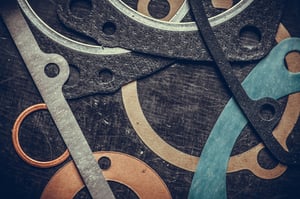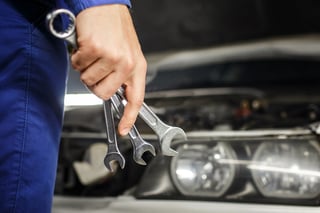How to Properly Install A Hydraulic Power Steering Seal
 One of the most important parts that protects the inner components that drive a power steering system is the input shaft seal. In order for a power steering system to operate, it must connect with a steering shaft. The steering shaft runs from the steering wheel and provides driver input to the power steering system. There are two seals that are used to make sure that dust does not enter while the power steering fluid is retained. The first seal is, quite literally, a dust cover. The second seal is the input shaft seal. This seal is responsible for preventing power steering fluid from leaking. If the seal is damaged, hydraulic fluid can leak from the power steering input shaft and eventually overheat the system or break down all together. So you can see why protecting these units is vital in order to keep your customers' vehicles in tip-top condition. So today, we're going to look at the most foolproof method used to install hydraulic power steering seals.
One of the most important parts that protects the inner components that drive a power steering system is the input shaft seal. In order for a power steering system to operate, it must connect with a steering shaft. The steering shaft runs from the steering wheel and provides driver input to the power steering system. There are two seals that are used to make sure that dust does not enter while the power steering fluid is retained. The first seal is, quite literally, a dust cover. The second seal is the input shaft seal. This seal is responsible for preventing power steering fluid from leaking. If the seal is damaged, hydraulic fluid can leak from the power steering input shaft and eventually overheat the system or break down all together. So you can see why protecting these units is vital in order to keep your customers' vehicles in tip-top condition. So today, we're going to look at the most foolproof method used to install hydraulic power steering seals.
First off, what are the common warning signs which indicate that a customer may need to replace their power steering seal? Well, there are three major ones that you should know and which you should inform your customers to be on the lookout for.
- Whining noises from the power steering when going into a turn
- Low power steering fluid with no obvious leaks from the hoses
- Power steering fluid leaks on the ground under the back end of the engine
So your customer comes in needing to replace their power steering seal. What are you going to need in order to replace it? Let's go through some materials you most definitely have laying around your shop that can help when it comes time to install a hydraulic power steering seal.
Hydraulic Power Steering Seal INstallation Materials
- Grease pen

- Liquid containment drain pan
- Replacement input shaft seal kit
- Ratchet or boxed end wrench
- Press fittings and line press
- Hydraulic line wrenches
- Large flat-blade screwdriver
- Multiple probes and seal removal screwdrivers
- Safety equipment
Now it's time to get down to business and begin the process of installing the actual power steering seal.
Process
- Disconnect the battery and lift the vehicle. As you know, this is always the first step when any work is being done on a vehicle. Always lift the car with a hydraulic lift or jacks and jack stands. After you've located the vehicle's battery, make sure to disconnect both the positive and negative battery cables.
- Remove the power steering gear from the car. This step is going to differ from vehicle to vehicle, so make sure you're referring to the specific service manual for the car you're working on for the correct instructions on how to remove the power steering gear.
- Clean the gearbox. Using a quality chemical solvent, thoroughly spray the outside of the gearbox and attempt to remove as much debris and grime as possible from the outside of the gearbox. You want to completely clean the gearbox before disassembly.
- Remove the input shaft face cover. After you've thoroughly cleaned the gearbox of any debris and dirt, you're going to remove the face cover from the input shaft itself. The face cover is designed to be the first line of defense against any possibly debris. Once you've removed this, set it aside as you'll need to reinstall it unless you plan on using a new one included in the input shaft seal kit.
- Mark the cover and housing. Using your grease pen, mark the location of the outside input shaft cover on the housing. This way, you'll be able to correctly reinstall the cover once you've replaced the seals inside.
- Remove bearing cap bolts and cover. Now it's time to remove the four bolts that hold the bearing cover onto the gear housing. Remove these and then the input shaft bearing from the housing. It's a good idea to then cover the housing with a clean rag to ensure no contaminants enter the gear set.
- Pry the soft seal from the cap cover. Pry the old dust seal from the inside of the input shaft bearing using a probe.
- Drive the input shaft seal with a seal driver. The input shaft seal needs to be inserted through the bearing center by using a seal driver with a press or a perfect sized socket and hammer. But it's best to utilize the press and seal driver method in this case.
- Remove the bearing cap. Does your installation kit have an o-ring? If so, you should replace it at the same time that you remove the input shaft seal. Do this by removing the o-ring with a flat blade screwdriver or a metal probe.
- Clean the input shaft bearing. Now it's time to clean the input shaft bearing with a can of solvent. Make sure to dry it thoroughly with a clean rag before you reinstall the new input shaft seal.
- Install input shaft seal. OK, we've reached the installation step! To begin, place the cover face down and lightly coat the outside of the input shaft seal with oil. Using an arbor press or a seal driver, install the new input shaft seal. Then, reinstall the other components in the reverse order of the removal stage.
- Prep the car. Make sure you fill the power steering fluid reservoir to the indicator line and reconnect the battery cables so that the car is ready to go.
- Test the vehicle. The final step is to start the car, test everything and check underneath for any leaks.


